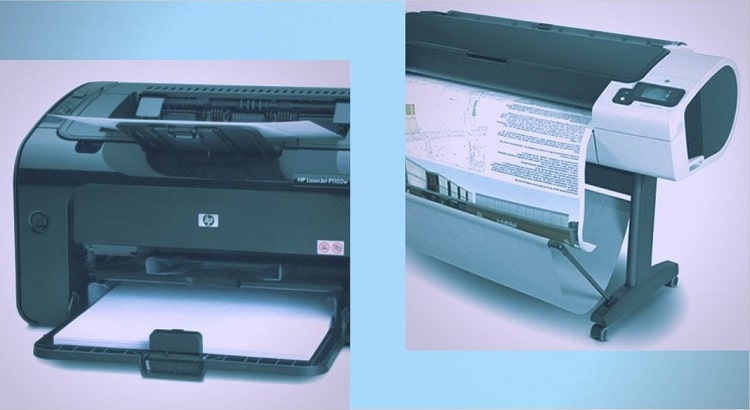Plotters were invented in the early '60s and it was the entire rave back in the day. Companies spent a lot of money and time investing in plotters as it was quite efficient in printing on a large scale and large media.
However, its spot in the limelight was quickly overtaken when wide-format printers came into being during the '90s. Up to this day, most industries and manufacturers opt for printers instead of plotters, but what do we know about the mechanics of these two machines? Where do their differences lie?
Contents
What is a Plotter ?
A plotter is a device that produces graphical images, usually on paper. Plotters are used to print designs and drawings, such as blueprints or schematics. Pen plotters draw images using a pen that moves across the paper. The pen is controlled by a computer, which sends instructions to the plotter about where to move the pen and what path to follow. Inkjet plotters work similarly to an inkjet printer, but instead of printing dots of ink onto paper, they draw lines.
Pros and Cons of Using a Plotter
Pros:
Some people may view using a plotter as an unnecessary expense. After all, couldn't you just print your designs out on a regular printer? While this is true, there are some definite advantages to using a plotter instead.
- Plotters can produce much higher quality prints than even the best home printers. If you're looking for professional-looking results, a plotter is definitely the way to go.
- Plotters are much faster than printers when it comes to printing large quantities of prints. So if you need to print a lot of copies of a design, a plotter will be able to do it much more quickly than a printer could.
- Plotters can handle a wider variety of media than printers can. So if you need to print on something other than standard paper, a plotter can probably do it.
- Plotters are generally more durable than printers. So if you plan on using your plotter for a long time, it's likely to last longer than a printer would.
- Plotters usually come with built-in cutter blades. This means that you can print out your designs and then cut them out with theplotter, rather than having to do it by hand. This can save you a lot of time and effort.
Cons:
So those are some of the advantages of using a plotter. Of course, there are also some disadvantages to using one as well.
- Plotters can be quite expensive. If you're just starting out in your business, you may not have the budget for a high-end plotter.
- Plotters can be very large and bulky. So if you don't have a lot of space in your office for one, it might not be the best option for you.
- Plotters can be tricky to use. If you're not familiar with how to use them, it can be easy to make mistakes that could ruin your prints.
- Plotters require special paper and ink. So if you don't have these things on hand, you may find yourself having to order them from a supplier.
Overall, there are both advantages and disadvantages to using a plotter. It really depends on your individual needs and circumstances as to whether or not one is right for you.
What is a Format Printer?
A format printer is a device that connects to a computer and prints documents using a specific format. Format printers are often used to print labels, business cards, or other items that need to be printed in a specific way. Many format printers also have the ability to print in multiple colors, which can be useful for printing photos or other graphics.
Label printers are a type of format printer that is commonly used to print labels for products, clothing, or other items. Business card printers are another type of format printer that is frequently used to print business cards. Some format printers can also be used to print ID badges, tickets, or other types of documents. Format printers vary in terms of their features and capabilities, so it is important to choose one that will best suit your needs.
Pros and Cons of Using a Format Printer
Format printers are versatile machines that can print on a variety of media, including paper, fabric, and even metal. While they offer many benefits, there are also some potential drawbacks to using one.
Pros:
Some of the advantages of format printers include:
- Increased versatility - As mentioned above, format printers can print on a variety of different materials. This means that you can use them for a wider range of projects than a standard printer.
- Higher quality prints - Format printers typically produce better quality prints than standard printers. This is due to the fact that they use higher-quality inks and have more printing options available.
- Faster printing speeds - Format printers are generally faster than standard printers, meaning that you can get your prints done quicker.
Cons:
Some of the potential disadvantages of format printers include:
- Higher cost - Format printers tend to be more expensive than standard printers. This is due to the fact that they are more specialized machines.
- Limited compatibility - Not all computer systems are compatible with format printers. This means that you may not be able to use one with your current setup.
- Difficult to use - Format printers can be more difficult to use than standard printers, due to their increased functionality. This means that it may take some time to learn how to properly operate one.
Overall, format printers offer a number of benefits that make them well worth the investment. However, there are also some potential drawbacks that you should be aware of before making your purchase. Weighing the pros and cons will help you decide if a format printer is the right choice for your needs.
What Is The Difference Between A Plotter & A Format Printer?

Plotters
The fundamental difference between plotters and traditional printers is that plotters are vector scanners/devices. It follows a set of commands from the host computer and uses more than one pen to print out complex and detailed high-drawings such as graphs, blueprints, maps, etc.
The reason it can carry this out is that plotters can follow certain sets of commands. One of these commands is called 'move' wherein the movement of the carriage continues while the plotter pens are held and retained above the page. 'Draw' is another command in which the carriage will be moving but the pens will be positioned down on the page.
There are 4 different kinds of plotters: drum plotters, flat-bed plotters, cutting plotters, and Inkjet plotters. Drum plotters are more frequently used for prints that contain heavy detailed and intricate content such as architectural and engineering blueprints.
The formats which plotter printers can read are vector formats like DWG, CDR, and AI. Additionally, images can be magnified, and yet they would still retain their resolution - it is resolution-independent.
Plotters are output devices that can either be used as a peripheral component that you may attach to your computer or as a singular device containing its very own internal processor. Regardless, there is no denying that the printing quality of plotters is better and higher than that of regular printers. Precisely because of that, plotters are relatively costlier.
Format Printer
All printers are raster scan devices that are capable of only printing a solitary line at one time. Plotters, on the other hand, can sketch out continuous lines from one point to another at the same time. Unlike plotters, printers use a single needle or pen to carry out their functions.
Printers can read formats that are in JPG TIFF, BMP, and PDF. Instead of single A4 or A5 sheets, format printers work on rolls of media that are sliced off at desired lengths.
As we know by now, format printers - more commonly known as Wide-Format printers - have trumped over plotters since their invention. Unlike plotter machines, the time format printers take to get the work done is comparatively less.
Moreover, there is no limit to the width of the paper you can print on with these guys, as long as it fits through the carrier, you can print whatever you want! However, one drawback to these machines is that whenever an image is enlarged, the pixels get enlarged as well and its resolution decreases.
Just like plotters, these are also external output devices that you can connect to your computer. There are two kinds of format printers: inkjet and laser. Both types can be used to create large posters, banners, maps, charts, etc. on almost any and every media, even cloth and metal.
There are pros and cons when it comes to both of these printing devices - as with every other device, honestly - and a handful of apparent differences. However, regardless of their distinctions, they mostly carry out the same function and purpose.
The machinery of printing has come a long way since its genesis, but it would be more than safe to say that that the modernization of the printing press has always been and still is one of man's greatest emblems of progress.
Conclusion for a Plotter vs a Format Printer
There are some key differences between plotters and format printers that you should be aware of before making a purchase. Plotters are generally much larger and more expensive than format printers, and they are not as widely available. Format printers, on the other hand, are smaller, less expensive, and more widely available.
Plotters are used for large-format printing, such as posters, banners, and blueprints. Format printers are better suited for smaller projects, such as photos and flyers. Plotters can print at resolutions up to 1200 dpi, while format printers max out at 300 dpi.
Related posts:




